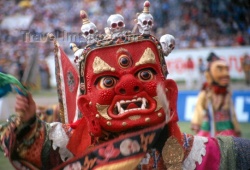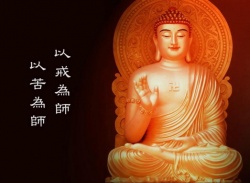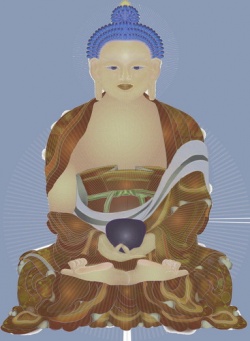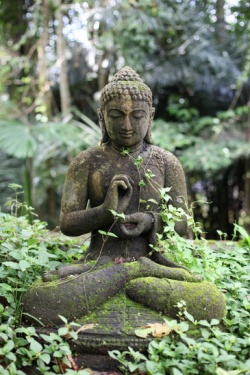Difference between revisions of "Kyerim"
Jump to navigation
Jump to search
| Line 6: | Line 6: | ||
:The [[development stage]] consists of three phases, known as ‘the [[three samadhis]]’: | :The [[development stage]] consists of three phases, known as ‘the [[three samadhis]]’: | ||
#The practice of [[Mahayoga]] begins with [[meditation]] on [[emptiness]], the ‘[[samadhi]] of as-it-isness’ where all [[phenomena]] are [[realized]] as [[empty]] in their [[pure]] [[nature]]. This is the [[realization]] of [[absolute bodhichitta]]. | #The practice of [[Mahayoga]] begins with [[meditation]] on [[emptiness]], the ‘[[samadhi]] of as-it-isness’ where all [[phenomena]] are [[realized]] as [[empty]] in their [[pure]] [[nature]]. This is the [[realization]] of [[absolute bodhichitta]]. | ||
| − | #From this state arise exuberant waves of [[compassion]] in what is known as the ‘[[samadhi]] of all-perceiving [[compassion]]’. This is the [[realization]] of [[relative bodhichitta]]. | + | #From this [[state]] arise exuberant waves of [[compassion]] in what is known as the ‘[[samadhi]] of all-perceiving [[compassion]]’. This is the [[realization]] of [[relative bodhichitta]]. |
| − | #The union of these two is known as the causal [[samadhi]], in which state arises a [[Main Seed Syllables|seed-syllable]], from which rays of light emerge, purifying the entire environment of [[samsara]] and the [[beings]] within it into the [[nature]] of [[emptiness]]. One’s [[mind]] becomes this [[seed-syllable]], which in turn transforms into the [[pure]] [[appearance]] of the [[deity]]. The [[mandala]] is seen as the palace of the [[deity]]. The [[form]] of the [[deity]] is the indivisible [[appearance]] of [[skilful means]] and [[wisdom]]. All [[experience]] is [[perceived]] as the retinue and [[activity]] of the [[deity]]. As one realizes that all [[perceptions]], {{Wiki|sounds}} and [[thoughts]] are the [[vajra-nature]], one rests in this state of [[vajra dignity]].<ref>''[[Dzogchen and Padmasambhava]]'', [[Rigpa]] Fellowship, 1989, page 62.</ref> | + | #The union of these two is known as the causal [[samadhi]], in which [[state]] arises a [[Main Seed Syllables|seed-syllable]], from which [[rays of light]] emerge, purifying the entire {{Wiki|environment}} of [[samsara]] and the [[beings]] within it into the [[nature]] of [[emptiness]]. One’s [[mind]] becomes this [[seed-syllable]], which in turn transforms into the [[pure]] [[appearance]] of the [[deity]]. The [[mandala]] is seen as the palace of the [[deity]]. The [[form]] of the [[deity]] is the indivisible [[appearance]] of [[skilful means]] and [[wisdom]]. All [[experience]] is [[perceived]] as the retinue and [[activity]] of the [[deity]]. As one realizes that all [[perceptions]], {{Wiki|sounds}} and [[thoughts]] are the [[vajra-nature]], one rests in this [[state]] of [[vajra dignity]].<ref>''[[Dzogchen and Padmasambhava]]'', [[Rigpa]] Fellowship, 1989, page 62.</ref> |
[[Dilgo Khyentse Rinpoche]] says: | [[Dilgo Khyentse Rinpoche]] says: | ||
| − | :“To practise the [[Inner Tantra]] one should realize that everything is [[primordially pure]]. Accordingly all outer [[elements]] are not [[perceived]] as ordinary, but as the [[five female buddhas]]. The [[five aggregates]] within the [[body]] are also not [[perceived]] as ordinary, but as the [[five male buddhas]]. In the same way, the [[eight consciousnesses]] as well as their eight [[objects]] are [[perceived]] as the [[eight great bodhisattvas|eight male]] and [[eight female bodhisattvas]]. In this way one will not only see the [[purity]] of all [[phenomena]], but one will also {{Wiki|perceive}} the ‘great evenness of [[samsara and nirvana]]’. So [[samsara]] is not considered to be something to be discarded and [[nirvana]] something to be achieved, but as the Great Union of [[purity]] and evenness. Such a state is not something which has to be [[fabricated]] anew; it has been there since the very beginning. | + | :“To practise the [[Inner Tantra]] one should realize that everything is [[primordially pure]]. Accordingly all outer [[elements]] are not [[perceived]] as ordinary, but as the [[five female buddhas]]. The [[five aggregates]] within the [[body]] are also not [[perceived]] as ordinary, but as the [[five male buddhas]]. In the same way, the [[eight consciousnesses]] as well as their eight [[objects]] are [[perceived]] as the [[eight great bodhisattvas|eight male]] and [[eight female bodhisattvas]]. In this way one will not only see the [[purity]] of all [[phenomena]], but one will also {{Wiki|perceive}} the ‘great evenness of [[samsara and nirvana]]’. So [[samsara]] is not considered to be something to be discarded and [[nirvana]] something to be achieved, but as the [[Great Union]] of [[purity]] and evenness. Such a [[state]] is not something which has to be [[fabricated]] anew; it has been there since the very beginning. |
:The [[essence]] of [[kyerim]], or [[Mahayoga]] is to [[recognize]] all [[appearances]] as the [[deity]], all {{Wiki|sounds}} as the [[mantra]], and all [[thoughts]] as the [[dharmakaya]]. This is the most profound [[path]], through which one can actualize all of the qualities of the [[body, speech and mind]] of the [[Buddha]].”<ref>''[[Dzogchen and Padmasambhava]]'', [[Rigpa]] Fellowship, 1989, pages 62-63.</ref> | :The [[essence]] of [[kyerim]], or [[Mahayoga]] is to [[recognize]] all [[appearances]] as the [[deity]], all {{Wiki|sounds}} as the [[mantra]], and all [[thoughts]] as the [[dharmakaya]]. This is the most profound [[path]], through which one can actualize all of the qualities of the [[body, speech and mind]] of the [[Buddha]].”<ref>''[[Dzogchen and Padmasambhava]]'', [[Rigpa]] Fellowship, 1989, pages 62-63.</ref> | ||
| Line 41: | Line 41: | ||
*[[Chögyam Trungpa]] and [[Herbert V. Guenther]], ''The Dawn of [[Tantra]]'' ([[Shambhala]], 1975) | *[[Chögyam Trungpa]] and [[Herbert V. Guenther]], ''The Dawn of [[Tantra]]'' ([[Shambhala]], 1975) | ||
*Collet-Cassart, Benjamin. ''The Generic Commentaries on [[Development Stage]] in the 18th and 19th Centuries A.D. A Study and Translation of [[Kunkhyen]] Tenpe Nyima's "Compendium of Key Instructions".'' [[Kathmandu]]: Unpublished MA {{Wiki|Thesis}}, 2011 | *Collet-Cassart, Benjamin. ''The Generic Commentaries on [[Development Stage]] in the 18th and 19th Centuries A.D. A Study and Translation of [[Kunkhyen]] Tenpe Nyima's "Compendium of Key Instructions".'' [[Kathmandu]]: Unpublished MA {{Wiki|Thesis}}, 2011 | ||
| − | *[[Dilgo Khyentse Rinpoche]], ''[[Pure]] [[Appearance]], Development and Completion Stages in [[Vajrayana]] Practice'', Translated by Ane Jinba [[Palmo]] ([[Vajravairochana]], 2002) (restricted) | + | *[[Dilgo Khyentse Rinpoche]], ''[[Pure]] [[Appearance]], [[Development]] and Completion Stages in [[Vajrayana]] Practice'', Translated by Ane Jinba [[Palmo]] ([[Vajravairochana]], 2002) (restricted) |
*[[Gyatrul Rinpoche]], ''[[Generating the Deity]]'', Translated by [[Sangye Khandro]] ([[Snow Lion]], 1996) | *[[Gyatrul Rinpoche]], ''[[Generating the Deity]]'', Translated by [[Sangye Khandro]] ([[Snow Lion]], 1996) | ||
| − | *[[Jamgön Kongtrul]] and [[Khenchen]] [[Thrangu Rinpoche]], ''Creation and Completion, [[Essential]] Points of [[Tantric]] [[Meditation]]'', Translated by [[Sarah Harding]] (Boston: [[Wisdom Publications]], 1996-2002) | + | *[[Jamgön Kongtrul]] and [[Khenchen]] [[Thrangu Rinpoche]], ''Creation and Completion, [[Essential]] Points of [[Tantric]] [[Meditation]]'', Translated by [[Sarah Harding]] ([[Boston]]: [[Wisdom Publications]], 1996-2002) |
*[[Jamgön Kongtrul]], ''The [[Treasury of Knowledge]], The System of [[Buddhist]] [[Tantras]]'', Translated by [[Kalu Rinpoche]] Translation Group, [[Snow Lion]], 2005 | *[[Jamgön Kongtrul]], ''The [[Treasury of Knowledge]], The System of [[Buddhist]] [[Tantras]]'', Translated by [[Kalu Rinpoche]] Translation Group, [[Snow Lion]], 2005 | ||
*[[Jikmé Lingpa|Jigme Lingpa]], [[Patrul Rinpoche]] and [[Gyurme Tsewang Chokdrup|Getse Mahapandita]], ''[[Deity]], [[Mantra]] and [[Wisdom]]: [[Development Stage]] [[Meditation]] in [[Tibetan Buddhist]] [[Tantra]]'', translated by the [[Dharmachakra]] Translation Committee (Ithaca: Snow Lion, 2007) | *[[Jikmé Lingpa|Jigme Lingpa]], [[Patrul Rinpoche]] and [[Gyurme Tsewang Chokdrup|Getse Mahapandita]], ''[[Deity]], [[Mantra]] and [[Wisdom]]: [[Development Stage]] [[Meditation]] in [[Tibetan Buddhist]] [[Tantra]]'', translated by the [[Dharmachakra]] Translation Committee (Ithaca: Snow Lion, 2007) | ||
Latest revision as of 23:38, 16 December 2015
Kyerim (Tib. བསྐྱེད་རིམ་, Wyl. bskyed rim; Skt. utpattikrama) is the ‘generation’ or ‘development phase’ of practice—otherwise known as visualization practice—the goal of which is to purify our perception into the purity of our inherent nature.
Sogyal Rinpoche writes:
- The development stage consists of three phases, known as ‘the three samadhis’:
- The practice of Mahayoga begins with meditation on emptiness, the ‘samadhi of as-it-isness’ where all phenomena are realized as empty in their pure nature. This is the realization of absolute bodhichitta.
- From this state arise exuberant waves of compassion in what is known as the ‘samadhi of all-perceiving compassion’. This is the realization of relative bodhichitta.
- The union of these two is known as the causal samadhi, in which state arises a seed-syllable, from which rays of light emerge, purifying the entire environment of samsara and the beings within it into the nature of emptiness. One’s mind becomes this seed-syllable, which in turn transforms into the pure appearance of the deity. The mandala is seen as the palace of the deity. The form of the deity is the indivisible appearance of skilful means and wisdom. All experience is perceived as the retinue and activity of the deity. As one realizes that all perceptions, sounds and thoughts are the vajra-nature, one rests in this state of vajra dignity.[1]
Dilgo Khyentse Rinpoche says:
- “To practise the Inner Tantra one should realize that everything is primordially pure. Accordingly all outer elements are not perceived as ordinary, but as the five female buddhas. The five aggregates within the body are also not perceived as ordinary, but as the five male buddhas. In the same way, the eight consciousnesses as well as their eight objects are perceived as the eight male and eight female bodhisattvas. In this way one will not only see the purity of all phenomena, but one will also perceive the ‘great evenness of samsara and nirvana’. So samsara is not considered to be something to be discarded and nirvana something to be achieved, but as the Great Union of purity and evenness. Such a state is not something which has to be fabricated anew; it has been there since the very beginning.
- The essence of kyerim, or Mahayoga is to recognize all appearances as the deity, all sounds as the mantra, and all thoughts as the dharmakaya. This is the most profound path, through which one can actualize all of the qualities of the body, speech and mind of the Buddha.”[2]
Notes
- ↑ Dzogchen and Padmasambhava, Rigpa Fellowship, 1989, page 62.
- ↑ Dzogchen and Padmasambhava, Rigpa Fellowship, 1989, pages 62-63.
Oral Teachings Given to the Rigpa Sangha on Kyerim
- Ringu Tulku Rinpoche, Lerab Ling, 10-13 (?) August 1996, commentary on Do Khyentse's text, Babble of a Fool.
- Orgyen Tobgyal Rinpoche
- Lerab Ling, 20-21 August 1997
- Lerab Ling, 26 July 1998, 17:00
- 'Kyerim, Dzogrim and the Six Yogas', Lerab Ling, 29th July 1999, 20:00
- Dzongsar Khyentse Rinpoche, Paris, 4 April 2004
- Dzigar Kongtrul Rinpoche, Teaching on the Ladder to Akanishtha, Lerab Ling, 21-25 August 2007
Edited Teachings (restricted titles)
- Orgyen Tobgyal Rinpoche
- Dzogchenlink September 2000, Kyerim, 1, Lerab Ling, 20 August 1997 (available in English and French, TAP 212)
- Dzogchenlink November 2000, Kyerim, 2, Lerab Ling, 21 & 23 August 1997 (available in English and French, TAP 213)
- Sogyal Rinpoche
- Dzogchenlink March 1999, How to Direct Your Practice, Lerab Ling & Paris, 8-9 October 1999 (TAP 202)
- Dzogchenlink July 2001, Dzogchen and Kyerim, Lerab Ling, 6 & 14 September 2000 (available in English and French, TAP 217)
- Dzogchenlink November 2005, Kyerim - Part 1, Lerab Ling, 20 July 2005, am (available in English and French, Ordernumber 243)
- Dzogchenlink January 2006, Kyerim - Part 2, Lerab Ling, 20 July 2005, am (available in English and French, Ordernumber 244)
Further Reading
- A Guide to Vajrayana Practice for the Rigpa Sangha (Lodeve: The Tertön Sogyal Trust, 2006), Section 2. 'Kyérim' (based on teachings by Orgyen Tobgyal Rinpoche).
- Chögyam Trungpa and Herbert V. Guenther, The Dawn of Tantra (Shambhala, 1975)
- Collet-Cassart, Benjamin. The Generic Commentaries on Development Stage in the 18th and 19th Centuries A.D. A Study and Translation of Kunkhyen Tenpe Nyima's "Compendium of Key Instructions". Kathmandu: Unpublished MA Thesis, 2011
- Dilgo Khyentse Rinpoche, Pure Appearance, Development and Completion Stages in Vajrayana Practice, Translated by Ane Jinba Palmo (Vajravairochana, 2002) (restricted)
- Gyatrul Rinpoche, Generating the Deity, Translated by Sangye Khandro (Snow Lion, 1996)
- Jamgön Kongtrul and Khenchen Thrangu Rinpoche, Creation and Completion, Essential Points of Tantric Meditation, Translated by Sarah Harding (Boston: Wisdom Publications, 1996-2002)
- Jamgön Kongtrul, The Treasury of Knowledge, The System of Buddhist Tantras, Translated by Kalu Rinpoche Translation Group, Snow Lion, 2005
- Jigme Lingpa, Patrul Rinpoche and Getse Mahapandita, Deity, Mantra and Wisdom: Development Stage Meditation in Tibetan Buddhist Tantra, translated by the Dharmachakra Translation Committee (Ithaca: Snow Lion, 2007)
- Padmasambhava and Jamgön Kongtrül, The Light of Wisdom, Vol II, translated by Erik Pema Kunsang (Boudhanath, Hong Kong & Esby: Rangjung Yeshe, 1998), Ch. 19-23.
- Ringu Tulku, Daring Steps Towards Fearlessness: The Three Vehicles of Buddhism, Snow Lion, 2005 (Includes a translation and commentary to Do Khyentse's Babble of a Fool, a text on kyerim)
- Tulku Urgyen Rinpoche, Rainbow Painting, Translated by Erik Pema Kunzang, Rangjung Yeshe, 1995
- Tulku Urgyen Rinpoche, As It Is, Volume 1, Rangjung Yeshe, 1999



